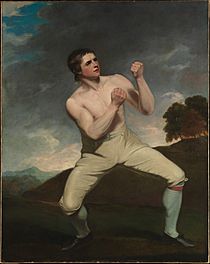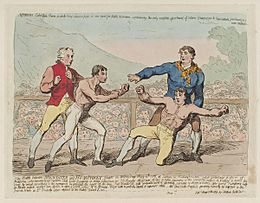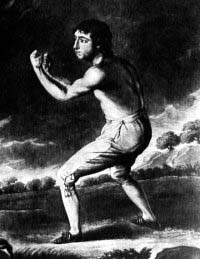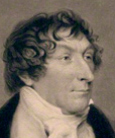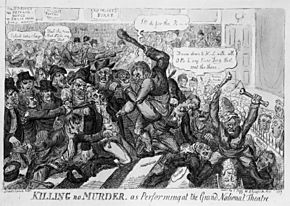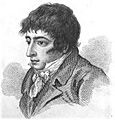Daniel Mendoza facts for kids
Quick facts for kids Daniel Mendoza |
|
|---|---|
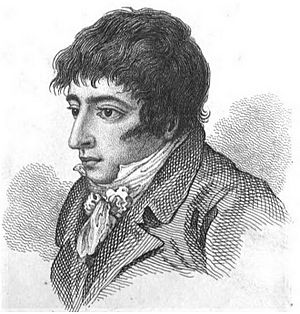 |
|
| Statistics | |
| Nickname(s) | Mendoza the Jew The Star of Israel |
| Rated at | 160 lb (73 kg) |
| Height | 5 ft 7 in (1.70 m) |
| Nationality | English |
| Born | 5 July 1764 Whitechapel, Aldgate, England |
| Died | 3 September 1836 (aged 72) Horseshoe Alley, Petticoat Lane, London, England |
| Stance | Orthodox |
| Boxing record | |
| Total fights | 37 |
| Wins | 31 |
| Losses | 5 |
| Draws | 1 |
Daniel Mendoza (born July 5, 1764 – died September 3, 1836), also known as Dan Mendoza, was a famous English boxer in the late 1700s. He was also a respected teacher of boxing. Daniel Mendoza was from a Sephardic, or Portuguese Jewish, family.
Mendoza helped change boxing by making it more scientific. He wrote two books about boxing, The Art of Boxing and The Modern Art of Boxing. He also held many public boxing shows. Many people today say Mendoza was the English Prizefighting Champion from 1792 to 1795. However, old records from his time do not call him champion.
Contents
Early Life and Family
Daniel Mendoza was born in Whitechapel, London, England, on July 5, 1764. His family was part of the Spanish and Portuguese Jews, also called Sephardim. By the time Daniel was born, Jewish people had been allowed to live in England for about 100 years. Even so, many Londoners were suspicious of them and they faced unfair treatment.
Mendoza's family came from Jaén, Spain. They moved to the Netherlands, which was more accepting. Then, his family moved to London. Daniel went to a Jewish school called Shaare Tikvah. There, he learned English, writing, math, and Hebrew. He grew up in a poor part of London. Before becoming a boxer, he worked as a glass cutter, a laborer, and an assistant at a grocery store.
Early Boxing Career (1780–1790)
Daniel Mendoza's first fight happened in 1780 when he was 16. He was working for a tea seller in London. The fight was not for money, but to settle an argument. A porter, who delivered tea, asked for too much money. Mendoza felt the porter was cheating his boss.
Mendoza decided to fight the porter for his boss. Richard Humphries helped Mendoza during the fight. Humphries later became Mendoza's manager. The fight took place in the street and lasted 45 minutes. Mendoza won when the porter gave up. This win made Mendoza a little famous. People heard stories of how the young Mendoza beat a bigger opponent.
Fight with Harry the Coalheaver (1784)
Mendoza became a professional boxer at 18. In 1784, he fought Harry the Coalheaver. This fight lasted an amazing 118 rounds, or 40 minutes! Mendoza won against the larger man.
Fights with Tom Tyne (1785 and 1786)
Mendoza then fought Tom Tyne, a tailor. Their first fight was on November 7, 1785. Tyne won this fight after 40 minutes.
In July 1786, Mendoza had a rematch against Tyne. This second fight took place in Croydon. Mendoza won this time after 27 rounds, which lasted almost an hour.
Fight with Sam Martin (1787)
On April 17, 1787, Mendoza fought Sam Martin, known as the Bath Butcher. Mendoza won in 10 rounds, which took 26 minutes. After his win, a cheering crowd followed him home. The Prince of Wales, who later became King George IV, gave Mendoza 500 pounds. This was on top of the 500 pounds he won from the fight! The Prince even shook Mendoza's hand. This royal recognition made Mendoza very famous. It also helped improve how Jewish people were seen in London.
With his winnings, Mendoza opened a boxing school. Around 1789, he married Esther Mendoza. They had eleven children. Daniel often found it hard to support his large family.
Fights with Richard Humphries (1787–1790)
Mendoza then had a series of important fights with his former helper, Richard Humphries. Their first fight was on September 9, 1787. Mendoza lost this fight in 29 minutes.
Their second fight was on January 9, 1788, in Odiham. About 10,000 people watched, including the Prince of Wales. The Prince of Wales and the Duke of York bet a lot of money on the match. Humphries was expected to win, but Mendoza had many supporters, especially from the Jewish community.
During the fight, Mendoza said he slipped on the wet ring floor. He badly sprained his ankle and had to stop fighting. This meant he lost the match. Many newspapers in England and the United States wrote about these fights. Mendoza even challenged Humphries in a newspaper, saying Humphries was "afraid" to fight him.
Mendoza's third fight against Humphries was on May 6, 1789. Mendoza was much better in this fight. He won in the 65th round when Humphries fell without being hit. Mendoza had trained hard for this fight.
Mendoza won his fourth and final fight with Humphries on September 29, 1790. This fight lasted 72 rounds. Mendoza was favored to win and easily beat Humphries. A boxing writer named Pierce Egan said that Mendoza showed great kindness during the fight. He often held back his punches when Humphries was tired.
First Fight Versus Bill Warr
On May 14, 1792, Mendoza fought Bill Warr, who used to be his sparring partner. Mendoza won this fight in 23 rounds, which lasted 116 minutes. After this win, Mendoza is believed to have met King George III at Windsor Castle. People wrote poems and songs about Mendoza. He posed for paintings and gave boxing shows in London. He earned a good amount of money for these shows.
Mendoza's Boxing Style
Boxing writer Pierce Egan called Mendoza "one of the most elegant and scientific pugilists." He said Mendoza was a "star" in boxing for a long time. Another book from 1812 said Mendoza's style had more skill than brute strength. His punches were not always the strongest, but they were incredibly fast. He was known for hitting often and blocking punches very well.
Mendoza's style also included blocking a punch and hitting back with the same hand. He used a "chopper," which was a backhanded punch. He was also good at making his opponents tired by playing defense until he could attack successfully. Mendoza learned boxing from Humphries, but he quickly improved and became even better.
Mendoza as a Teacher
Mendoza helped boxing grow not just by his fighting, but also by his teaching. In 1789, he published two books: The Art of Boxing and The Modern Art of Boxing. From 1790, he often gave public boxing shows in theaters. Mendoza also worked with other boxers as a trainer or a second (like a cornerman today). Egan said Mendoza was an excellent teacher and trained many good students.
Mendoza's books included "Six Lessons" for his students. These lessons showed how a student could defend against different attacks. These lessons showed Mendoza's focus on defense and counter-attacking.
Later Career (1793–1795)
Mendoza's popularity began to decline. After spending time in a prison for people who owed money, he started training again. He defeated Bill Warr again on November 12, 1794. Mendoza won easily in just 17 minutes. Around this time, Mendoza also worked as a recruiting sergeant.
Fight against John Jackson (1795)
On April 15, 1795, Mendoza fought "Gentleman" John Jackson. Jackson was 26, five years younger than Mendoza, and much taller and heavier. The future King William IV was in the audience. Jackson won the fight in nine rounds. He pushed Mendoza into a corner, grabbed his hair, and hit his head with uppercuts. Mendoza tried to continue, but Jackson knocked him out. Mendoza said Jackson cheated by pulling his hair. However, hair-pulling was allowed in boxing at that time. Many boxers shaved their heads to avoid this. Hair-pulling was later banned.
Mendoza stopped boxing after this loss. He tried to make comebacks, but he never had the same large audiences or earned as much money. His popularity and income went down after 1795.
In 1799, Mendoza owed money and was sent to Carlisle Prison. Friends helped him get out, but he later served another six months. In 1806, he became a Sheriff's Assistant. However, he had to avoid prison again later in life because of more debts.
Return to Boxing vs. Harry Lee (1806)
On March 21, 1806, Mendoza returned to the ring. He defeated Harry Lee in 53 rounds. Mendoza was favored to win because of his past fame. During this time, Mendoza ran a pub called the "Admiral Nelson." He turned down many offers for rematches. In 1807, he wrote a letter to The Times newspaper saying he was focusing on teaching boxing.
In 1809, Mendoza was hired to help stop the Old Price Riots. These riots were violent protests against higher ticket prices at a new theater. This event made Mendoza less popular. People saw him as fighting for the rich. The anger also led to more unfair treatment against Jewish people, including Mendoza.
He published his third book, his life story called "Memoirs of the Life of Daniel Mendoza," in 1816. Mendoza also went on several boxing exhibition tours. His most successful tours were in the summer of 1819.
Final Loss and Death (1836)
Mendoza's last public boxing match was on July 4, 1820, just before his 56th birthday. He fought Thomas Owen, a London innkeeper who was five years younger. Mendoza had not fought in 14 years. He needed money and made a poor choice to fight. He lost after 12 rounds.
Mendoza continued to work as an innkeeper in his later years. He died on September 3, 1836, at age 72. He left his wife, Esther, and their eleven children in poverty. He was first buried in a Jewish cemetery near Mile End. Later, he was reburied in Brentwood Jewish Cemetery in Essex, England.
Pierce Egan, a boxing historian, called Mendoza "a complete artist" and a "star of the first brilliancy." Egan also said that Mendoza taught the rules of boxing better than almost anyone else.
Claim to the English Championship
Many modern sources say Mendoza was the English Prizefighting Champion from 1792 to 1795. This period includes his wins against Bill Warr and his loss to John Jackson. However, older records from the late 1700s and early 1800s do not call Mendoza a champion.
Newspaper reports from Mendoza's fights in 1792, 1794, and 1795 do not say these fights were for the championship. They also do not call Mendoza the champion. Even Mendoza's own autobiography does not say he was the English Champion.
According to Pierce Egan's book Boxiana (1813), Ben Brain was recognized as champion until he died in 1794. The championship then seemed to be empty until Jem Belcher became champion in 1800.
Halls of Fame
- In 1954, Mendoza was chosen for The Ring magazine Hall of Fame (Boxing Hall of Fame).
- Mendoza was added to the International Jewish Sports Hall of Fame in 1981.
- In 1990, he was part of the first group of people inducted into the International Boxing Hall of Fame.
- In 2017, Mendoza was inducted into the Bare Knuckle Boxing Hall of Fame.
Images for kids
See also
 In Spanish: Daniel Mendoza (boxeador) para niños
In Spanish: Daniel Mendoza (boxeador) para niños
- List of select Jewish boxers



